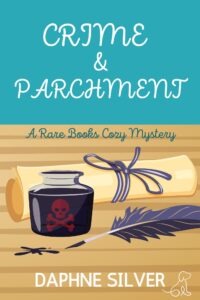Today, I’m hosting fellow Level Best Book author, Daphne Silver, on my website blog. Take it away, Daphne…
There are so many things I love about cozy mysteries: quirky characters, charming locales, and taking a virtual escape. However, the thing I love most about mysteries is the puzzle. It’s fun trying to solve the mystery alongside our hero. As both a reader and a writer, I want my mysteries to be like Goldilocks: not too easy and not too difficult to figure out. Part of that is using red herrings.
The phrase “red herring” potentially comes from William Cobbett. In 1807, he told a story about using smoked fish to distract some hunting hounds from chasing a rabbit. Since then, the phrase has become a popular literary device. Red herrings are misleading clues. They’re frequently used to divert attention away from the mystery’s actual solution. Some examples of red herrings include planted or misleading evidence that suggest the wrong killer; a character acting suspiciously for reasons that turn out to be unrelated to the mystery; and coincidences that incorrectly appear to connect to the crime.
Many authors love to employ red herrings. Agatha Christie’s mysteries regularly led the reader to suspect one killer, when the correct answer turned out to be completely different. In both Christie’s stories and Arthur Conan Doyle’s mysteries, the police frequently believe clues they find at face value, while our sleuths – Hercules Poirot, Miss Marple, and Sherlock Holmes – understand that things are rarely how they seem. Red herrings continue to be loved by contemporary authors. Take, for instance, Gone Girl by Gillian Flynn or The Girl with the Dragon Tattoo by Stieg Larsson.
However, you have to be careful not to go overboard with the red herrings. Just like the actual fish is pungent, the author should use these devices carefully. Too many can make a story confusing and convoluted, leading to reader frustration. Additionally, the author should make sure the red herrings are neither too obscure or too obvious. It’s all about finding the right balance. Many red herrings have become cliches, and while it’s impossible to escape all cliches, it’s best if the author can put a new and unexpected twist on them.
While many readers – myself included – enjoy being surprised by the solution, the answer should feel plausible within the context of the story. When everything is revealed, the reader should understand how the real clues were distinguished from the fake ones. They should also know the story behind every red herring, which is another reason not to have too many.
I wrote my cozy mystery Crime and Parchment in two stages. In the first stage, I used the discovery technique of writing and seeing where the story took me. Along the way, I realized some clues were more relevant to the mystery than others. When I rewrote the story in the second stage, I tried highlighting the misleading ones: the red herrings. Because my protagonist Juniper Blume is a rare books librarian, she is naturally curious about any historic objects and how they’re connected to people in the story. Sometimes that led her down false rabbit holes, but not always. Which ones are the real clues? You’ll have to read Crime and Parchment to find out!
Rare books librarian Juniper Blume knows this much… an ancient Celtic manuscript shouldn’t be in a Maryland cemetery. But that’s exactly what her brother-in-law claims. Last year, Juniper saw the 1,200-year-old Book of Kells in Ireland. She learned how their bejeweled covers were stolen centuries ago, never to be seen again. So how could they have ended up in Rose Mallow, a small Chesapeake Bay town? Being Jewish, the Book of Kells might not be her sacred text, but as a rare books librarian, the ancient book is still sacred to her, making it important to Juniper to find out the truth. Rose Mallow is the same place where Juniper used to summer with her sister Azalea and their grandmother Zinnia, known as Nana Z. Ever since Nana Z passed away, Juniper’s avoided returning, but her curiosity is greater than her grief, so she heads down in her vintage convertible with her rescue dog Clover. Juniper discovers that her sister Azalea has transformed their grandmother’s Queen Anne style mansion into the Wildflower Inn, backing up to the Chesapeake Bay. Although Juniper isn’t much of a cook, Azalea has kept their grandmother’s legacy alive, filling the house with the smells of East European Jewish treats, like sweet kugels and tzimmes cake. Will coming back here feel like returning home or fill Juniper with a deeper sorrow? Can she apologize to her sister for not being there when she was needed most?
Buy Crime and Parchment: https://amzn.to/3VgeBe1
About Daphne Silver
Daphne Silver is the Agatha-nominated author of the Rare Books Cozy Mystery series. The first in the series ‘Crime and Parchment’ is nominated for the Agatha Award for Best First Mystery Novel. She’s worked more than twenty years in museums and symphonies and has the great fortune of being married to a librarian. When she’s not writing, she’s drawing and painting. She lives in Maryland with her family. Although she’s not much of a baker, she won’t ever turn down a sweet lokshen kugel.
Join Daphne’s newsletter and get the free short story “A Midsummer’s Night Scheme” at www.daphnesilver.com.
Find Daphne on Social Media
Daphne’s Website: daphnesilver.com
Facebook: www.facebook.com/daphnesilverbooks
Instagram: www.instagram.com/daphnesilverbooks



Daphne, your post made a point that hit home with me. Be careful not to have TOO many red herrings. Doing so leads to confusion rather than fun puzzle-solving. I needed this right at this time. Thanks to you and Susan.